
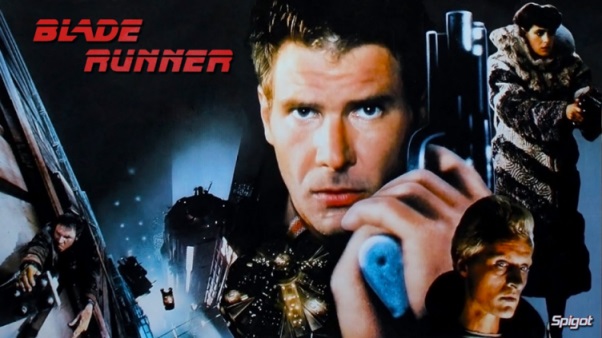
If the definition of a Dystopia is the idea of a society, generally of a speculative future, characterized by negative, anti-utopian elements – well, Bladerunner is pretty much the definition of a dystopian film. Based extremely loosely on Philip K Dick’s novel ‘Do Androids dream of electric sheep”, it was a project picked up by Ridley Scott, as his follow up to Alien. He had originally been planning the movie of Dune, but this was becoming tied up and delayed, and when his brother tragically died, he decided he needed a project he could immerse himself in. It may be this death in the family is partly what created such a dark vision of the future. Certainly, the budget limitations often worked in the movies favour. The low budget meant that the studio backlot had to be used, and therefore to make the backlot look ‘real’ the shots were done at night, and with lots of rain added. Smoke was used to cover up the lackings of the set. The wet night time conditions worked to add tension to the set, and the smoke, dark, and rain fed into what became the iconic ‘look’ of the movie. In terms of tone, it’s a sci-fi film noir, with the film noir elements of cinematography, hard bitten detective and femme fatale.. but this mashing of genres belies a deeper subtext of mortality, implications of man’s increasing mastery (or meddling, depending which side of the fence you are) of science such as genetic engineering. There are recurring themes, such as eyes, which feature prominently.. a nod to ‘Big Brother’, perhaps?
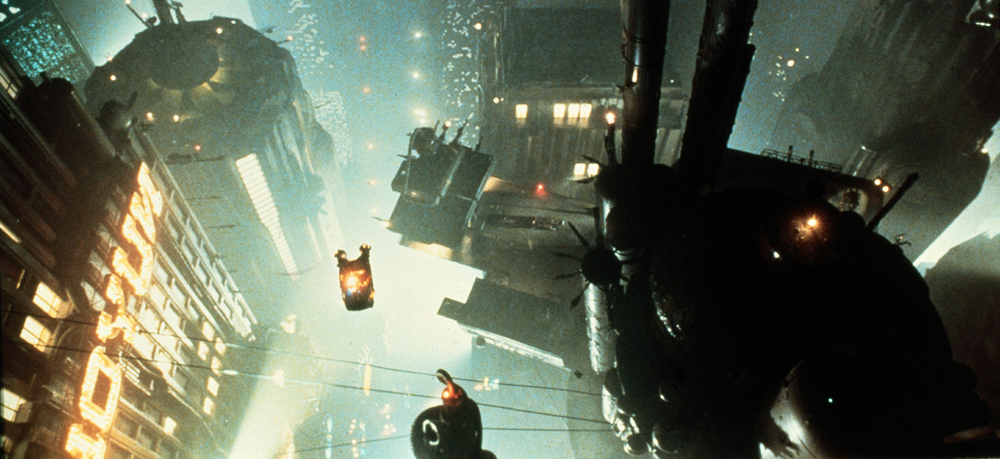
The effects were all done in camera – this was the last major sci-fi movie to use non cgi effects, which again added to the feeling of reality, creating a sense of weight and gravity that is extremely hard to replicate (pun intended) in cgi. Most of all, the effects were not being done to shout ‘look at me’.. they each had a very specific use towards telling the story. And of course, it’s impossible to talk about Bladerunner without mentioning the soundtrack by Vangelis, which added a unique dimension to the final product.
The grueling shoot which went significantly over budget, amidst huge and much publicized tensions between cast, crew and director, resulted in an original working assembly put together by Scott, which was basically so beautifully shot it was essentially an art film. This was not what people had expected after Alien… it went to a test audience, who were confused, and a joint decision was made to insert a voiceover to help clear up some of the areas of confusion. However, while Scott’s idea was to have Deckard muse philosophically on his actions, the producers wanted something which was a straightforward telling the audience exactly what was going on. Harrison Ford famously hated it, and it was the icing on the cake which cemented his ill feeling to the movie for many years. It was not until 2007 he spoke publicly on his views of the movie, and the ‘clowns’ who wrote the voiceover. Additionally, the movie was so dark, the producers insisted on a bright and cheerful ending being added on, with Deckard and Rachel driving off into a beautiful sun bathed scenic road, completely at odds with the tone of all that had preceded it. The producers then forced Scott to make cuts to the movie – “If it doesn’t mean something, we’ll cut it out” – this took away many of the subtleties and lyrical nature of the movie.
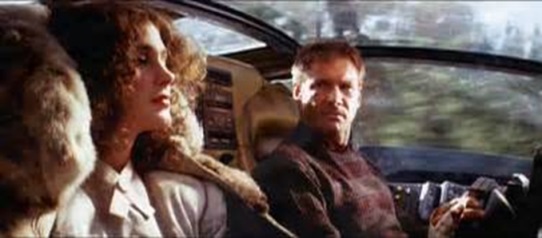
Certainly these attempts to make the movie more commercially viable, do not appear to have been entirely successful. Critics were divided, with even the reliable Roger Ebert being somewhat disdainful... “Stunningly visual but a failure as a story” was his verdict. It performed poorly. However, over the coming years home video was just taking off, and the movie gained a cult audience.. The aesthetic of the movie started getting copied and referenced in other movies, in music videos and even in fashion. When the original 70mm working cut was discovered and shown at a film festival, demand to have this released to a wider audience grew, so the producers took the working cut, took out the voice over and the happy ending, and released it as ‘The Director’s Cut’ in 1992, ten years after the original release. Scott was never involved in this release however, and had a strong desire to put the film right, to release his actual vision. Attempts were made as early as 2000, but it was not until 2007 that the movie was digitally restored using the original negatives – which had been earmarked for incineration, before they were saved by those doing the restoration. They fixed the sound, made the minor changes, including the famous unicorn scene. This was a scene filmed by Scott at the end of shooting, on the stage being set up for his next film, ‘Legend’. It was seen as a pivotal through story of the film, of Deckard’s memory (implanted, or real..?) of Unicorns, making his own identity more ambiguous.
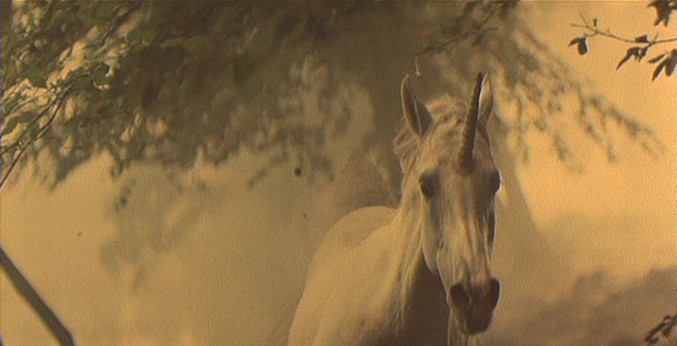
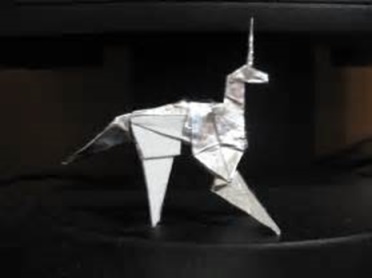
Ford and Scott never did agree on whether Deckard himself was a replicant, and this ambiguity has been one of the reasons the film has maintained such popularity – the fact that people can interpret the movie both ways, or the fact it is hard to tell really supports the whole idea of questioning what mortality is, actually adds to the richness of the movie. Certainly, in 2007, upon release of The Final Cut, Ebert somewhat revised his original opinion of the film and added it to his list of Great Movies, while noting, "I have been assured that my problems in the past with Blade Runner represent a failure of my own taste and imagination, but if the film was perfect, why has Sir Ridley continued to tinker with it?”
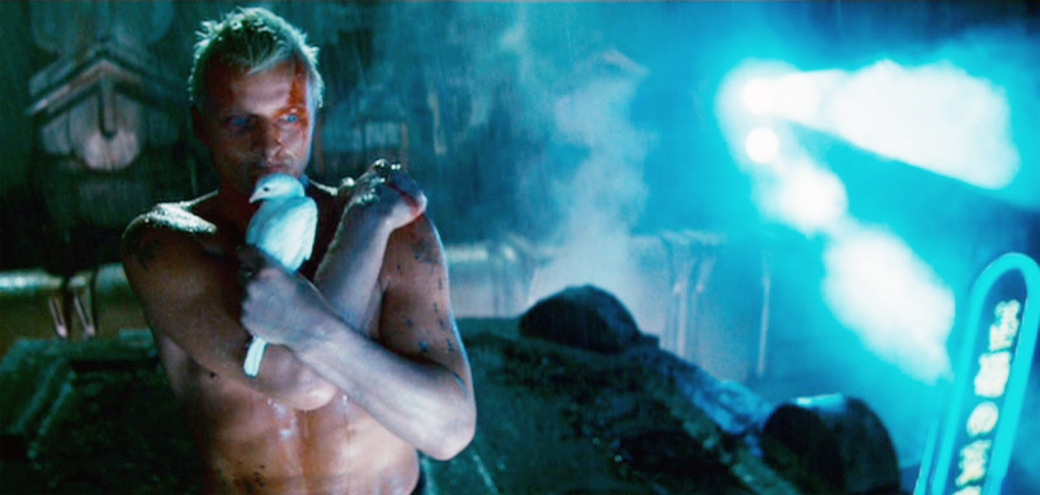
So does this Final Cut represent tinkering gone too far – or does it help finesse one of the acknowledged masterpieces of modern cinema? Has the 30 year old view of the future become dated, or scarily prescient? Watch it again, and make up your own mind.
Trivia:
Dustin Hoffman was the original choice to play Deckard, although he wondered why he was asked to play a "macho character". According to Ridley Scott, Hoffman was interested, but wanted to make it a whole different kind of character.
Although Philip K. Dick saw only the opening 20 minutes of footage prior to his death on March 2, 1982, he was extremely impressed, and has been quoted by Paul Sammon as saying, "It was my own interior world. They caught it perfectly." However neither Ridley Scott nor screenwriter David Webb Peoples actually read Dick's novel.
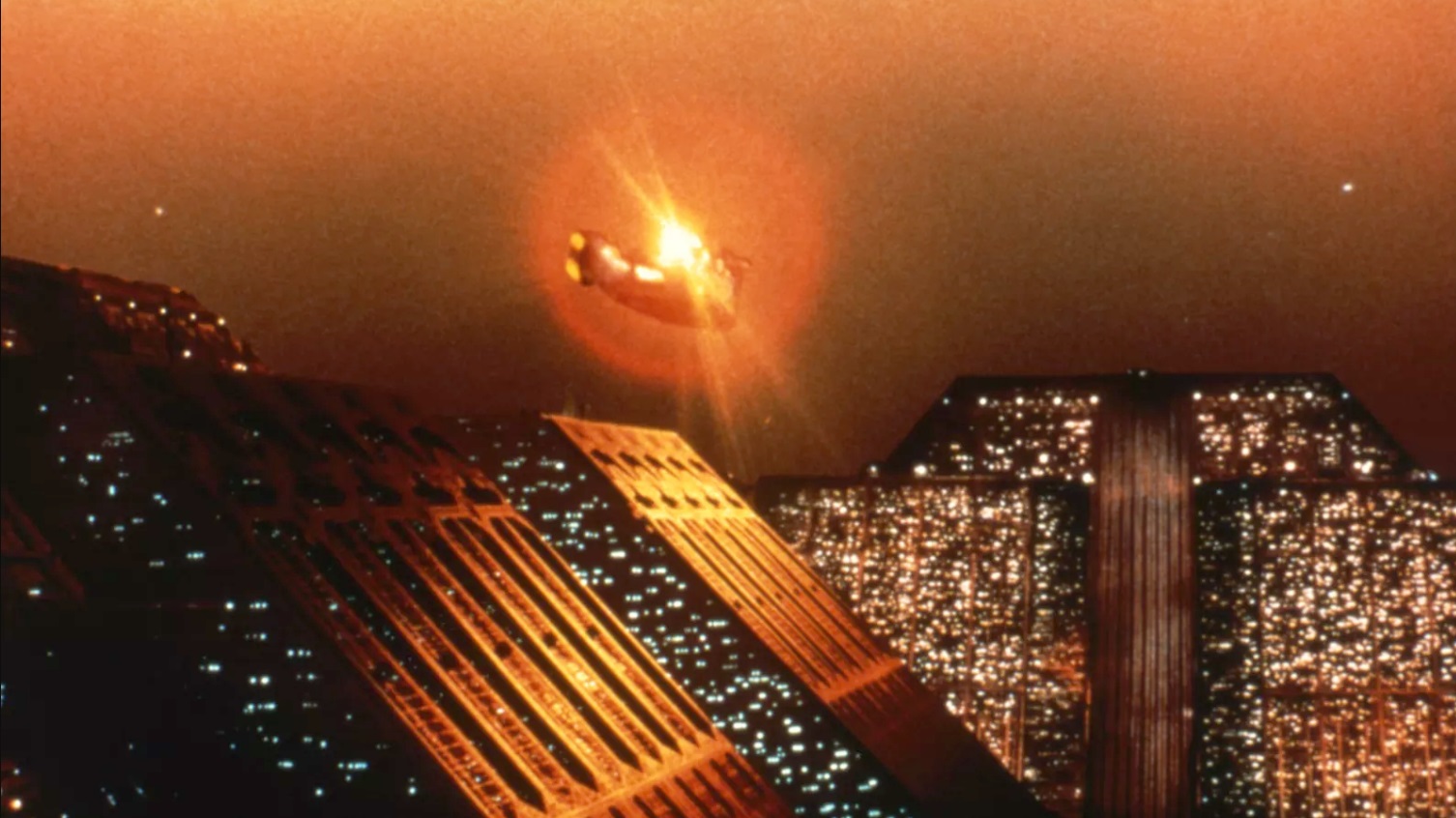
Exasperated crews often referred to the film as "Blood Runner".
The Hades landscape in the opening shot was filmed using forced perspective. The miniature itself was only 13 feet deep and 18 feet wide. Almost seven miles of fiber optics and over 2000 lights were needed to illuminate it.
Originally, the novel (Do Androids Dream of Electric Sheep?) was set in 1992, although later editions brought the date forward to 2021. The film makers initially identified the date as 2020, but settled on 2019 because 2020 sounded too much like the common term for perfect vision, 20:20.
Philip K. Dick's ideal choice for Rachel was Victoria Principal. Although almost one hundred actresses auditioned for the role, only three were seriously considered: Sean Young, Nina Axelrod and Barbara Hershey. For the auditions, the role of Deckard was played by Morgan Paull, who ultimately went on to play Holden (the guy in the first scene) in the film since Scott liked working with him.
Roy Batty (Rutger Hauer)'s odd meld of "father" and "fucker" after he says to Tyrell, "I want more life" is deliberate. Hauer was instructed to pronounce it in such a way that it could be both; "fucker" was to be used in the theatrical cut, "father" in all versions of the film for TV.
When Deckard (Harrison Ford) stops Rachael (Sean Young) from leaving his apartment, he pushes her away from him. The expression of pain and shock on her face was real. She said Ford pushed her too hard and she was angry with him.
Joanna Cassidy (Zhora) was at ease with the snake around her neck because it was her pet, a Burmese python named Darling.
Ridley Scott and Jordan Cronenweth achieved the famous 'shining eyes' effect by using a technique invented by 'Fritz Lang' for his 1926 masterpiece “Metropolis”, known as the 'Schüfftan Process'; light is bounced into the actors' eyes off a piece of half mirrored glass mounted at a forty five degree angle to the camera.
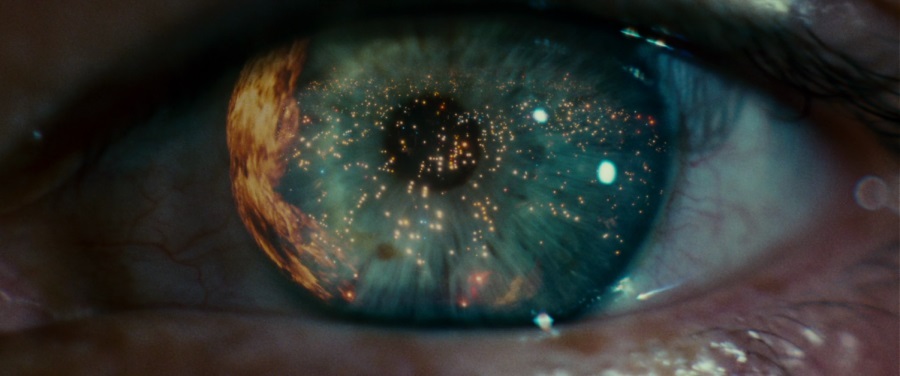
For the scene in the bathroom where Deckard finds the snake scale, Deckard is played by Harrison Ford's double Vic Armstrong as the scene was shot in England as a pickup, and Ford was unavailable
For the first aerial shot of the city, showing the Asian billboard for the first time, a kitchen sink can be seen masquerading as a building in the far background of the shot.
After Pris (Daryl Hannah) first meets Sebastian (William Sanderson, she runs away from him, skidding into his car and smashing the window with her elbow. This was a genuine mistake caused by Hannah slipping on the wet ground. The glass wasn't breakaway glass, it was real glass, and Hannah chipped her elbow in eight places.
The 'snake scale' seen under the electron microscope was actually a marijuana bud.
At one point in the film, Deckard buys a bottle of Tsingtao beer from a street vendor. Tsingtao is a real Chinese beer, created in 1903 and still being produced. It is one of China's most successful beers and has also appeared in other films such as Gran Torino and The Crow.
When we first see Deckard driving his sedan, it's raining but the windscreen wipers are not switched on. This was because the wipers on the stage prop were not working.
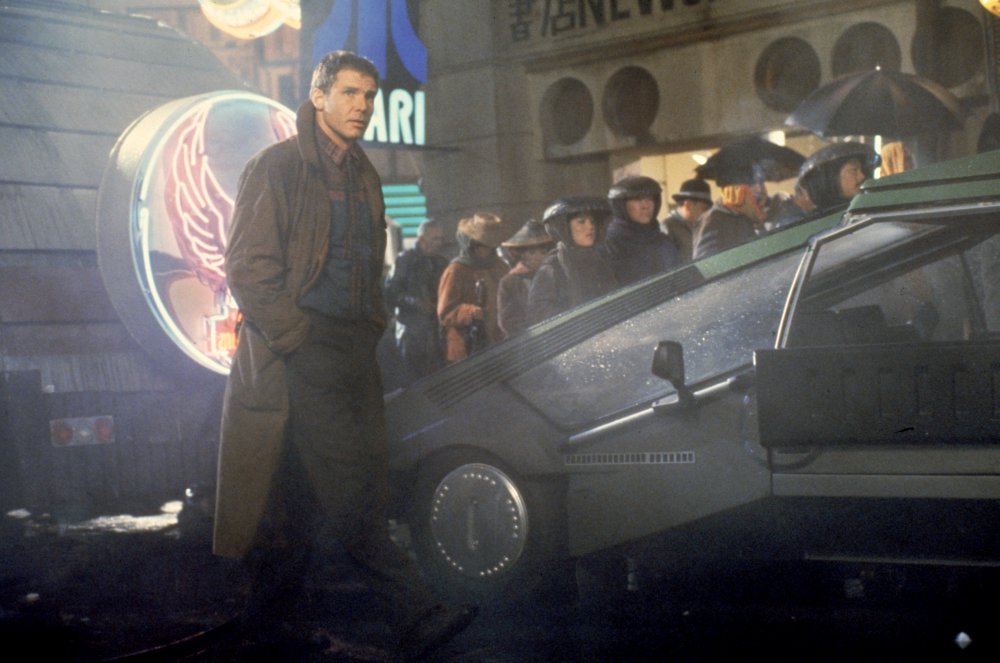
The Voight-Kampff Test (the test in the first scene) comes from Cambridge Mathematician Alan Turing's 1951 paper in which he proposed a test called "The Imitation Game" that might finally settle the issue of machine intelligence. One of David Webb Peoples's early screenplays opened the movie on an Off-World Termination Dump, where three dead replicants were to be disposed of. Peoples reused this idea of discarding dead servants on an off-world colony dump in his screenplay for Soldier, which he considered a 'side-quel' to Blade Runner (1982) (i.e. an unrelated movie taking place in the same fictional universe).
Spoilers
The trivia items below may give away important plot points.
The dialog in all releases of the movie prior to the Final Cut alludes to another replicant who dies before Deckard's final battles with Pris and Batty. The conflicting dialog occurs in the first conversation between Deckard and Bryant. Bryant initially tells Deckard there are four "skin jobs" on the loose, but minutes later says six escaped, and one was killed by the "electronic gate", which should leave five. The explanation is that the script originally contained an additional replicant named "Mary", but time and budgetary constraints resulted in her being written out. The role was removed at such a late stage, that it had already been cast. Mary was to be played by Stacey Nelkin. Nelkin had auditioned for the role of Pris, but after her audition, she was offered Mary instead. M. Emmet Walsh who plays Bryant, reports that new dialog was recorded to change the number of replicants in this scene, but Scott inexplicably only used half of the new dialog, resulting in the inconsistency. This inconsistency is corrected in the Final Cut version of the film, although interestingly, in the Workprint, Byrant does indeed say "two" replicants were killed. There are lengthy debates among the movie's fandom on whether Deckard is a replicant himself, the sixth replicant is believed by some to be Deckard.
The idea for Roy to release a dove after he dies was Rutger Hauer's. The dove was supposed to release itself and fly away just after Batty's death. But while filming the scene, the large amount of water used for the rain soaked the dove, rendering it unable to fly. Instead it simply hops out of Batty's hand and walks away.
At some point of the movie, each replicant has a red brightness in their eyes (Rachael in Deckard's home, Pris in Sebastian's). Deckard also has the shining in his eyes while talking to Rachael in his house. In July 2000, director Ridley Scott said that Deckard is, in fact, a replicant. Harrison Ford takes issue with this, however. "We had agreed that he definitely was not a replicant," Ford said. Rutger Hauer's autobiography expressed some disappointment with the same, because it reduced the final clash between Deckard and Batty from a symbolic "man vs. machine" battle to two replicants fighting.
Originally, Roy Batty (Rutger Hauer) was to have a lengthy monologue just prior to his death, as written by David Webb Peoples. Hauer felt this didn't help in creating any dramatic impact in the scene, so he removed much, keeping the pieces he liked, and then added the last two lines, "All those moments will be lost in time, like tears in rain. Time to die."
Director Ridley Scott and actor Harrison Ford had disagreements about the script almost from the very start. Ford hated the voiceover which Scott was proposing and he was against the idea that Deckard may be a replicant, feeling it undercut the human story of Deckard discovering his lost humanity (Rutger Hauer agreed completely with Ford on this point). According to Ford, Ridley Scott and he agreed prior to shooting that Deckard was not a replicant, but then Scott went and shot it to imply he could be, which disappointed both Ford and Hauer.
© Stephen's Movie Guide
Inverurie Website Design